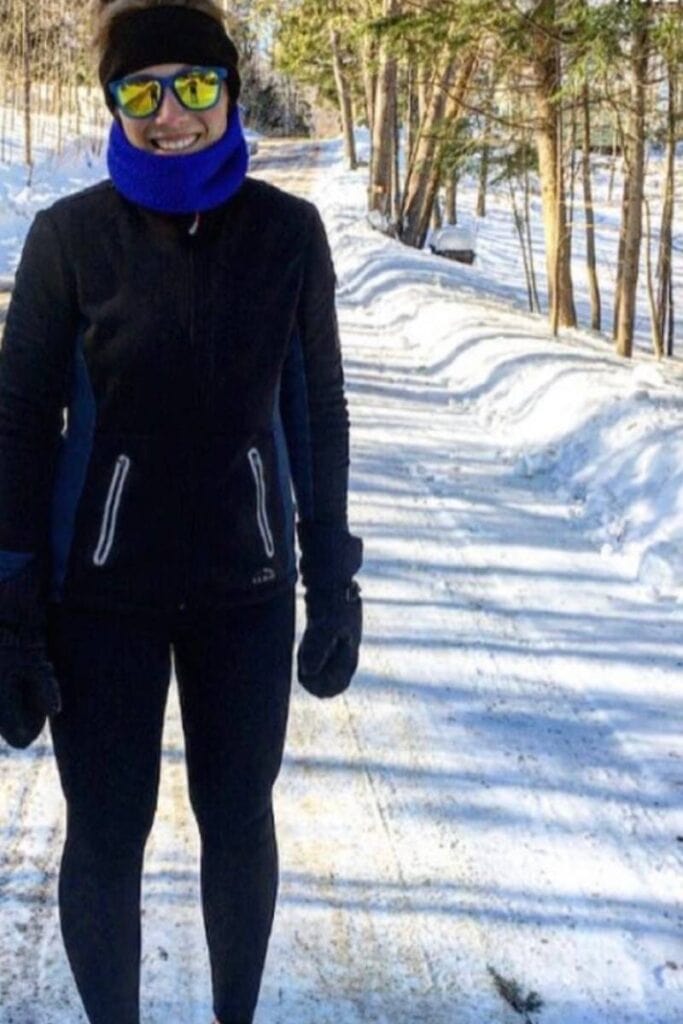9 Common Winter Running Mistakes (And What to Do Instead!)
After a hot and humid summer, many runners welcome cooler temperatures with open arms. However, be aware of these common winter running mistakes that people often make. Taking just a few extra minutes before your run can help you prepare and avoid these frequent errors.
Frequently Asked Questions – Winter Running Mistakes:
Is it harder to run in the winter?
Yes, running is typically more challenging in winter. Not only are runners faced with freezing temperatures, but also snow, ice, and less daylight. Furthermore, our bodies are less adaptable, so running takes more effort and is why wearing layers and performing a proper warmup is key.
Why is it harder to run in winter?
Braving the cold temperatures and running on ice and snow covered roads will make running feel harder than in other seasons. Cold air causes our muscles to tighten so we may feel like we’re exerting more effort than usual while possibly running slower. Running on ice and snow will also cause us to use smaller muscles to help us stay balanced and upright.
Additionally, running is more challenging in the winter because our bodies work harder to keep organs warm. Because there is less oxygen and blood moving to our extremities, our muscles become less efficient at using oxygen that is present in our muscles.
Is it bad to run during cold weather?
If you have the right gear and mindset, running in the cold weather is not bad. It may take a few more minutes to prepare, but ensuring you are dressed appropriately can make for a peaceful, safe and successful run.
However, be aware of the temperature and weather conditions. Even with the right gear, you may need to alter your run or the amount of time you spend outside. Staying flexible is essential for training throughout the winter.
9 Common Winter Running Mistakes – And What to Do Instead:
1. Focusing too much on pace
Just like running in very hot weather affects our paces, so will running in freezing temperatures. Additionally, running on snow covered and icy roads will naturally lead to a change in pace. This is okay – please don’t worry! Choosing to focus too much on pace can lead to over stressing the body and make workouts and easy effort runs harder than they need to be.
To avoid this mistake: Run off effort and ignore your watch.
Related: Follow my Rate of Perceived Effort Guide for guidance on how to run off effort.
2. Forgetting to drink enough water
We may not return from our runs dripping like we do in the summer, but this doesn’t mean we’re not sweating. Dehydration is still very common in the winter and unfortunately, is a cause of injury. Even if you don’t feel like you need it, drink fluids just like you would in the summer months.
To avoid this mistake: Carry fluids with you. Continue to drink throughout long runs, rehydrate after finishing a run, and replenish electrolytes.
3. Overdressing…or underdressing
When the temperatures drop, it’s easy for runners to wear all the layers. However, too many layers can actually trap your sweat and keep you chilly. Check the weather before every run, add ten degrees to the “feels like” temperature, and dress for that. Keep in mind, you should feel cold when you step outside. You will warm up and can always take layers off.
On the other hand, be aware of any exposed skin. Not covering your ears, nose, and fingers can make for a not-so-fun run and lead to frostbite.
To avoid this mistake: Dress in light weight and quick-drying layers. Always avoid cotton!
Related: What to Wear for Cold Weather Running
4. Running without the right gear
Running on slippery roads and sidewalks without any spikes on your sneakers is an injury waiting to happen. Don’t tell yourself, “I’ll be careful” – this is very risky!
In addition to checking the weather forecast, check the conditions of the road. Do you see fresh snow or ice? Is it freezing rain? Are the roads completely dry? Even if you’re not sure whether the roads are icy or dry, bring spikes anyway. If you don’t need them, you can always take your spikes off and carry them.
To avoid this mistake: Invest in a pair of Kahtoola NANOspikes to wear on icy and snowy roads or wait to run until the sun has melted the ice and snow.
5. Skipping a warmup
Warmups are essential before running no matter the season, but particularly in the winter when our muscles are cold. Taking time to properly warmup before a run activates the muscles we need to use and can decrease the risk for injury.
Additionally, it may take a few more minutes of easy running to feel warmed up before heading into a workout.
To avoid this mistake: Spend 5-10 minutes before every run doing some dynamic stretches and a glute activation routine. Stay flexible and be willing to extend your warmup before jumping right into faster running.
Related: Glute Activation Warm Up – 5 Best Exercises and Benefits for Runners
6. Not being flexible
It’s best to approach winter training with a flexible mindset. You may find yourself in situations where you need to alter your run on the spot.
- Weather – Most days, running outside will be fine if you have the proper gear. However, extremely cold temperatures, heavy snow, and ice are reasons to take your run inside to the treadmill. Possibly getting hurt outside is not worth the risk when you can safely run indoors.
- Schedule changes – If there’s a blizzard and you don’t have access to a treadmill, it’s probably best to skip your run that day and move it to another time during the week. Be okay with switching some runs around, especially if it revolves around your safety.
- Paces – Effort takes precedence! Maybe you’re running a workout at half marathon effort and the pace you see on your watch is slower than what your typical half marathon pace is. Take a deep breath, cover up your watch, take your mind off pace, and focus on exerting whatever effort is prescribed in your workout.
To avoid this mistake: Work to develop a growth mindset and know that safety is most important.
7. Running only indoors
If you have access to a treadmill, view it as a tool in your toolkit. On some days, running on the treadmill might be the best option in terms of safety. However, choosing to run indoors all winter is a missed opportunity for building your mental strength, running on varying terrain, and getting fresh air. Keep in mind, we grow when we push ourselves outside of our comfort zone!
To avoid this mistake: Run outside unless you absolutely need to run indoors.
Related: How to Build Mental Toughness – 6 Ways Runners Build Mental Strength
8. Increasing mileage too quickly
Many runners spend the winter training for spring races, and with the New Year right around the corner, many people set goals to exercise and be more active. While creating and sustaining a healthy lifestyle is awesome, runners need to stay cautious about running too much too soon. For example, ramping up weekly mileage too quickly can lead someone straight to an injury.
To avoid this mistake: Continue increasing mileage by no more than 10% a week and include cutbacks every few weeks.
Related: 3 Guidelines for Setting Running Goals
9. Running without lights
Daylight is limited during the winter, so you may oftentimes find yourself running in the dark. Don’t assume that cars and other people will see you even if you’re wearing bright colors and running against traffic.
To avoid this mistake: Run in well lit areas and wear a headlamp and Noxgear Tracer360 Reflective Vest.
Recap of Common Winter Running Mistakes:
Before heading out for a run this winter, take a few extra minutes to prepare. Make sure you are not only wearing the appropriate clothing and gear but also have the right mindset to safely train in the cold and avoid these common running mistakes.
- Focusing too much on pace
- Forgetting to drink enough water
- Overdressing…or underdressing
- Running without the right gear
- Skipping a warmup
- Not being flexible
- Running only indoors
- Increasing mileage too quickly
- Running without lights
Looking for Guidance With Your Running?
Eager to avoid these winter running mistakes? I would love to help you train! Email me at [email protected] or check out my Run Coaching Services page to learn more.
Comment Below:
What is a goal you have for your training this winter?
If you’ve trained through cold weather before, what’s one thing you learned?














